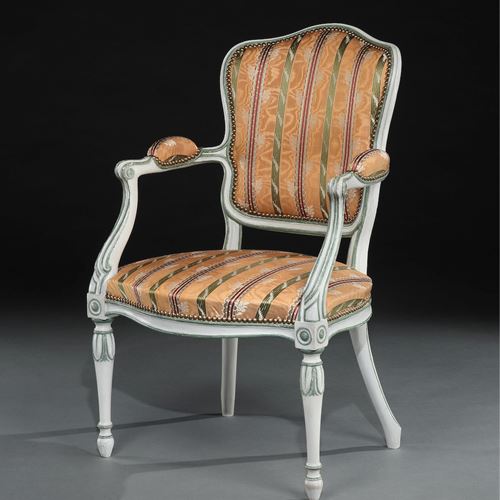search
1/4
THE EARL OF CHESTERFIELD'S SALOON CHAIRS
england , circa 1770
SOLD
An exceptional pair of George III Chippendale period giltwood armchairs from the collections of the Earls of Chesterfield, and subsequently the Earls of Harewood.
In the neo-classical taste with exceptionally finely carved giltwood show-frames, standing on cabriole legs and the seats, backs and arms upholstered with fine floral needlework in tones of green and pink on a white background, probably circa 1800 - 1820.
An exceptional pair of George III Chippendale period giltwood armchairs from the collections of the Earls of Chesterfield, and subsequently the Earls of Harewood.
In the neo-classical taste with exceptionally finely carved giltwood show-frames, standing on cabriole legs and the seats, backs and arms upholstered with fine floral needlework in tones of green and pink on a white background, probably circa 1800 - 1820.
Provenance
The chairs, part of a suite presumably commissioned by the 4th Earl of Chesterfield (d. 1773) or the 5th Earl of Chesterfield (d. 1816) for Chesterfield House, London, around the time of his marriage to Anne Thistlethwaite in 1777.
Presumably transferred along with much of the 18th century furniture from Chesterfield House to Bretby Hall, ancestral country seat of the Chesterfields in Derbyshire in the early 19th century. The suite, likely recorded in the 1817 Inventory of Bretby Hall in the Upper Drawing Room: ‘2 handsome sofas one each side of chimney the frames, carved gilt in BG (burnished gold) wth thick squabs, 14 feather pillows, covered with crimson damask, decorated with gold colour silk lace, tafsells’. In the same room are recorded: ‘8 cabriole chairs, carved and gilt in BG, covered with crimson damask’. The Chesterfield House Inventory of the same date records in No 21, Red Room: ’10 large Elbow chairs, carved and gilt the backs, seat and elbows, stuffed and covered with crimson damask’. It is possible that this is all the same suite.
At least six chairs and two sofas sold from Bretby Hall, Christie’s London, Catalogue of Old English and French Furniture and Porcelain being a portion of The Bretby Heirlooms Passing under the Wills of the 7th Earl of Chesterfield and the Dowager Countess of Chesterfield…..also the Property of the Earl and Countess of Carnarvon, 29- 30 May 1918, lot 115 described as “A suite of Old English Furniture, of Louis XV design, the frameworks carved with shells and foliage, partly painted and gilt, the seats and backs stuffed, and covered with needlework with flowers and key-pattern in coloured wools, consisting of – Six armchairs Two settees”.
Acquired at the above sale by the 6th Earl of Harewood for his London residence, Chesterfield House. The 6th Earl had also written to his mother on 2 June 1918 to let her know that he had bought some items from Bretby, including 'a set of 6 chairs + 2 sofas'. (credit: Letter from Viscount Lascelles to 5th Countess of Harewood, 2 June 1918, 5th Countess of Harewood Archive, Harewood House Archive ).
Inlcuded in a 1920 inventory of Chesterfield House carried out on behalf of Lord Lascelles: "A suite of Old English furniture in the Louis XVth. style, decorated in pink and gold and carved with leaf stringing shells and acanthus and gadroon borders, the seats and panel backs stuffed and covered in needlework designed with bouquets of flowers in key bordered panels on floral spray ground, comprising;-
7ft 6in. Settee with serpentine back on 8 legs.
A ditto
and a set of 6 Fauteuils.
Part of the suite photographed in situ in Chesterfield House in 1922.
Transferred to Harewood House, Yorkshire upon the sale of Chesterfield House in 1932.
Sold Christie’s London, 23 May 1968, lot 107, ‘The Property of the Right Honourable the Earl of Harewood’ (six armchairs and two settees)
With Mallett & Son (Antiques) Ltd., London
Private Collection
With Mallett & Son (Antiques) Ltd., London
Private Collection, UK
Presumably transferred along with much of the 18th century furniture from Chesterfield House to Bretby Hall, ancestral country seat of the Chesterfields in Derbyshire in the early 19th century. The suite, likely recorded in the 1817 Inventory of Bretby Hall in the Upper Drawing Room: ‘2 handsome sofas one each side of chimney the frames, carved gilt in BG (burnished gold) wth thick squabs, 14 feather pillows, covered with crimson damask, decorated with gold colour silk lace, tafsells’. In the same room are recorded: ‘8 cabriole chairs, carved and gilt in BG, covered with crimson damask’. The Chesterfield House Inventory of the same date records in No 21, Red Room: ’10 large Elbow chairs, carved and gilt the backs, seat and elbows, stuffed and covered with crimson damask’. It is possible that this is all the same suite.
At least six chairs and two sofas sold from Bretby Hall, Christie’s London, Catalogue of Old English and French Furniture and Porcelain being a portion of The Bretby Heirlooms Passing under the Wills of the 7th Earl of Chesterfield and the Dowager Countess of Chesterfield…..also the Property of the Earl and Countess of Carnarvon, 29- 30 May 1918, lot 115 described as “A suite of Old English Furniture, of Louis XV design, the frameworks carved with shells and foliage, partly painted and gilt, the seats and backs stuffed, and covered with needlework with flowers and key-pattern in coloured wools, consisting of – Six armchairs Two settees”.
Acquired at the above sale by the 6th Earl of Harewood for his London residence, Chesterfield House. The 6th Earl had also written to his mother on 2 June 1918 to let her know that he had bought some items from Bretby, including 'a set of 6 chairs + 2 sofas'. (credit: Letter from Viscount Lascelles to 5th Countess of Harewood, 2 June 1918, 5th Countess of Harewood Archive, Harewood House Archive ).
Inlcuded in a 1920 inventory of Chesterfield House carried out on behalf of Lord Lascelles: "A suite of Old English furniture in the Louis XVth. style, decorated in pink and gold and carved with leaf stringing shells and acanthus and gadroon borders, the seats and panel backs stuffed and covered in needlework designed with bouquets of flowers in key bordered panels on floral spray ground, comprising;-
7ft 6in. Settee with serpentine back on 8 legs.
A ditto
and a set of 6 Fauteuils.
Part of the suite photographed in situ in Chesterfield House in 1922.
Transferred to Harewood House, Yorkshire upon the sale of Chesterfield House in 1932.
Sold Christie’s London, 23 May 1968, lot 107, ‘The Property of the Right Honourable the Earl of Harewood’ (six armchairs and two settees)
With Mallett & Son (Antiques) Ltd., London
Private Collection
With Mallett & Son (Antiques) Ltd., London
Private Collection, UK
Stock number
R10.183
dimensions
More Details
Literature
Height: 37³/₈ in (95 cm)
Width: 26 in (66 cm)
Depth: 20¹/₂ in (52 cm)
Width: 26 in (66 cm)
Depth: 20¹/₂ in (52 cm)
This exceptional suite of chairs has long been recognised as masterpieces of English furniture design but despite examples from the suite appearing with leading dealers and at auction on many occasions, its early history had not been established, and the suite was erroneously thought to have been supplied by Chippendale to Harewood House. In fact, these highly important chairs were most likely commissioned by the Earl of Chesterfield for Chesterfield House, one of the most important and flamboyant rococo interiors of the time.
Philip Stanhope, 5th Earl of Chesterfield, was the godson and adopted heir to the 4th Earl (d. 1773), whose own son had died in 1768. The Stanhope’s ancestral home was Bretby Hall, Derbyshire; the estate had been acquired in 1639 and a house built by Thomas Stanhope after his grandson Philip had been made Earl of Chesterfield by King Charles I.
The 4th Earl was an inveterate townsman spending time in London and on the continent after he was sent as envoy to the Hague in 1728. In fact he shunned Bretby, writing in 1725 when his own father was dying in the house, that it was a ‘seat of horror and despair, where no creatures but ravens, screech owls and birds of ill omen seem willingly to dwell’. Thus he spent much of this time in London, where he built the mansion Chesterfield House on South Audley Street, Mayfair in 1748 – 49, employing the architect Isaac Ware, who rose to prominence under the patronage of Lord Burlington and whose Designs of Inigo Jones and Others was first published in 1731. The Palladian house was thought magnificent by his contemporaries. The 4th Earl, a famous man of letters, wrote to Madame de Monconseil in 1747 ‘I am at present in the process of ruining myself by building a fine house... which will be finished in the French style with abundance of sculptures and gilding’. Chesterfield House was Ware’s masterpiece; his subsequent Complete Body of Architecture, published in 1756, makes repeated references to the house in a whole section entitled 'The construction of a town-house of the greatest elegance'.
The 5th Earl (d. 1816) was a favoured companion to George III. In 1764 he became a member of the Privy Council, and was appointed Ambassador to Spain, a post he held until 1787, although he never actually visited the country, and was later Master of the Mint (1789 – 90). Unlike his godfather he was very much a man of the country, he was an enthusiast for hunting and delighted in superintending the operations of his estates. The enthusiasm is recorded in Thomas Weaver’s painting of 1810 (previously Bretby Park, present location unknown), showing the Earl standing in a farmyard with his young son George (from his second marriage, and afterwards 6th Earl of Chesterfield), his agent and a prize heifer. Chesterfield House remained the Earl’s London townhouse and it seems that he was furnishing it in the latest fashionable taste subsequent to his marriage in 1777 to Anne Thistlethwaite, but it was used less often.
The 5th Earl ultimately rebuilt Bretby in 1813 – 1815, shortly before his own death. A new castellated mansion was designed by Jeffry Wyatt and much of the late 18th century furniture formerly at Chesterfield House was moved to Bretby where it was recorded in an inventory of 1817, presumably just after his death 1816.
George, 6th Earl of Chesterfield (1805-1866) inherited a great fortune at a young age, but spent heavily on horses and gambling. In 1830 he married the Hon. Anna Weld Forrester who bore him a son and a daughter. The daughter, Lady Evelyn Stanhope would marry the heir to the Earl of Carnarvon. It appears that by the 1840s the 6th Earl has given up Chesterfield House to a series of tenants, preferring to live more modestly in Grosvenor Square instead. The 7th Earl, unmarried, survived his father by five years – dying of typhoid fever in 1871. Bretby Hall and (presumably Chesterfield House) passed to his mother, the widow of the 6th Earl – and when she died her estates passed through her daughter's line to her eldest grandson the future 5th Earl of Carnarvon, who in turn sold off Bretby to finance his excavations in Egypt’s Valley of the Kings which would lead to the discovery of Tutankhamun’s tomb in 1922. Part of the Bretby Heirlooms were sold: Christie’s, London, 29 - 30 May 1918, “Catalogue of Old English and French Furniture and Porcelain being a portion of The Bretby Heirlooms Passing under the Wills of the 7th Earl of Chesterfield and the Dowager Countess of Chesterfield…..also the Property of the Earl and Countess of Carnarvon”. These chairs were included in the sale.
Chesterfield House was subsequently acquired by Lord Lascelles, the son of the Earl of Harewood. He was very interested in buying back furniture and paintings that had been made for Chesterfield House, most famously the series of portraits of literary men and poets that hung above the bookcases in the Library, which had gone to Bretby. The vast majority of furniture acquired by the 6th Earl for Chesterfield House was antique, and he was keen to ensure that the cultural heritage of the property was maintained. Since the sale of the contents of Bretby was handled by Christie's it is possible that a catalogue was sent to the 6th Earl, as he still received certain sale catalogues and magazines while serving in the trenches during the First World War. He asked Grogan and Boyd, his agents, to find out if anything in the Bretby sale had come from Chesterfield House - though the 6th Earl indicated that he already knew that some did. The 6th Earl knew that Bretby was the seat of the Earls of Chesterfield and their descendants, so it was possibly also an educated guess on his part that the family will have taken objects from Chesterfield House when they sold it in 1869. This was typical for the aristocracy - when the 6th Earl later sold Chesterfield House in 1932, he also removed some elements and took them to Harewood House. Wonderfully, the 6th Earl had also written to his mother on 2 June 1918 to let her know that he had bought some items from Bretby, including 'a set of 6 chairs + 2 sofas'. (credit: Letter from Viscount Lascelles to 5th Countess of Harewood, 2 June 1918, 5th Countess of Harewood Archive, Harewood House Archive). An invoice from D. Chapman, a 'carman and contractor', which was passed to the 6th Earl via Grogan and Boyd, through whom he had purchased Chesterfield House, confirms that between 19-24 August 1918 Chapman transported 'console tables and slats, pictures, sofas + chars, curtains +c' from Bretby Hall to London. This is of course several months after the Bretby sale had taken place, but as the 6th Earl was serving in the First World War in France during this period, the delay is to be expected. (credit: Invoice D. Chapman to Grogan & Boyd, 26 August 1918, forwarded to Viscount Lascelles by Grogan & Boyd, 6th Earl of Harewood Archive, Harewood House Archive).
Once the Lascelles family relinquished Chesterfield House in 1932, the sofas and chairs were moved to Harewood House until their sale in 1968.
These superb chairs with their graceful lines and delicately gadrooned edges typify transitional pieces of furniture made in the late 1760s and early 1770s which bridge the rococo and neo-classical periods in England. The chairs, originally part of a larger suite including two settees, share a numnber of similarities to seat furniture by some of the top London cabinet-makers including Thomas Chippendale, John Linnell and John Cobb.
John Linnell: Linnell supplied a very similar suite of seat furniture to William Drake for his house Shardeloes, Buckinghamshire, circa 1768 (cf. Hayward and Kirkham, pp. 34, 127, figs. 61 and 250). Similarities include the use of shells to the centre of the cresting rails and aprons and very similar legs and mouldings. They relate closely to designs by Linnell now held in the collections of the Victoria & Albert Museum in London (V&A E. 59 1929 and V7A E. 141 1929). The Shardeloes suite is now in the collection HM King Charles III.
John Cobb: The chairs with their distinctive gadrooned edges and finely carved knees relate to a group of seat furniture traditionally associated with the celebrated cabinet-maker John Cobb (d. 1778) of St Martin's Lane and upholsterer to George III from 1761. Examples of such chairs are illustrated in L. Synge, Mallett Millennium, London, 1999, pp. 158, fig. 192 and a suite from the de Souza collection illustrated in Partridge, Summer Exhibition, 1974, pp. 106-107.
We are grateful to the archives team at Harewood House, and in particular Dr. Gemma Plumpton who has made a particular study of the 6th Earl's purchases for their detailed help. Dr Plumpton's research is detailed in her PhD thesis titled 'Collecting Continental Old Masters for Harewood House, Yorkshire: British cultural heritage and aristocratic survival, 1916-1947'.
We are also extremely grateful to Richard P. Merriman for his help working through the 1817 inventory of the contents of Chesterfield House and Bretby Hall and for identifying the relevant entry for the armchairs.
Philip Stanhope, 5th Earl of Chesterfield, was the godson and adopted heir to the 4th Earl (d. 1773), whose own son had died in 1768. The Stanhope’s ancestral home was Bretby Hall, Derbyshire; the estate had been acquired in 1639 and a house built by Thomas Stanhope after his grandson Philip had been made Earl of Chesterfield by King Charles I.
The 4th Earl was an inveterate townsman spending time in London and on the continent after he was sent as envoy to the Hague in 1728. In fact he shunned Bretby, writing in 1725 when his own father was dying in the house, that it was a ‘seat of horror and despair, where no creatures but ravens, screech owls and birds of ill omen seem willingly to dwell’. Thus he spent much of this time in London, where he built the mansion Chesterfield House on South Audley Street, Mayfair in 1748 – 49, employing the architect Isaac Ware, who rose to prominence under the patronage of Lord Burlington and whose Designs of Inigo Jones and Others was first published in 1731. The Palladian house was thought magnificent by his contemporaries. The 4th Earl, a famous man of letters, wrote to Madame de Monconseil in 1747 ‘I am at present in the process of ruining myself by building a fine house... which will be finished in the French style with abundance of sculptures and gilding’. Chesterfield House was Ware’s masterpiece; his subsequent Complete Body of Architecture, published in 1756, makes repeated references to the house in a whole section entitled 'The construction of a town-house of the greatest elegance'.
The 5th Earl (d. 1816) was a favoured companion to George III. In 1764 he became a member of the Privy Council, and was appointed Ambassador to Spain, a post he held until 1787, although he never actually visited the country, and was later Master of the Mint (1789 – 90). Unlike his godfather he was very much a man of the country, he was an enthusiast for hunting and delighted in superintending the operations of his estates. The enthusiasm is recorded in Thomas Weaver’s painting of 1810 (previously Bretby Park, present location unknown), showing the Earl standing in a farmyard with his young son George (from his second marriage, and afterwards 6th Earl of Chesterfield), his agent and a prize heifer. Chesterfield House remained the Earl’s London townhouse and it seems that he was furnishing it in the latest fashionable taste subsequent to his marriage in 1777 to Anne Thistlethwaite, but it was used less often.
The 5th Earl ultimately rebuilt Bretby in 1813 – 1815, shortly before his own death. A new castellated mansion was designed by Jeffry Wyatt and much of the late 18th century furniture formerly at Chesterfield House was moved to Bretby where it was recorded in an inventory of 1817, presumably just after his death 1816.
George, 6th Earl of Chesterfield (1805-1866) inherited a great fortune at a young age, but spent heavily on horses and gambling. In 1830 he married the Hon. Anna Weld Forrester who bore him a son and a daughter. The daughter, Lady Evelyn Stanhope would marry the heir to the Earl of Carnarvon. It appears that by the 1840s the 6th Earl has given up Chesterfield House to a series of tenants, preferring to live more modestly in Grosvenor Square instead. The 7th Earl, unmarried, survived his father by five years – dying of typhoid fever in 1871. Bretby Hall and (presumably Chesterfield House) passed to his mother, the widow of the 6th Earl – and when she died her estates passed through her daughter's line to her eldest grandson the future 5th Earl of Carnarvon, who in turn sold off Bretby to finance his excavations in Egypt’s Valley of the Kings which would lead to the discovery of Tutankhamun’s tomb in 1922. Part of the Bretby Heirlooms were sold: Christie’s, London, 29 - 30 May 1918, “Catalogue of Old English and French Furniture and Porcelain being a portion of The Bretby Heirlooms Passing under the Wills of the 7th Earl of Chesterfield and the Dowager Countess of Chesterfield…..also the Property of the Earl and Countess of Carnarvon”. These chairs were included in the sale.
Chesterfield House was subsequently acquired by Lord Lascelles, the son of the Earl of Harewood. He was very interested in buying back furniture and paintings that had been made for Chesterfield House, most famously the series of portraits of literary men and poets that hung above the bookcases in the Library, which had gone to Bretby. The vast majority of furniture acquired by the 6th Earl for Chesterfield House was antique, and he was keen to ensure that the cultural heritage of the property was maintained. Since the sale of the contents of Bretby was handled by Christie's it is possible that a catalogue was sent to the 6th Earl, as he still received certain sale catalogues and magazines while serving in the trenches during the First World War. He asked Grogan and Boyd, his agents, to find out if anything in the Bretby sale had come from Chesterfield House - though the 6th Earl indicated that he already knew that some did. The 6th Earl knew that Bretby was the seat of the Earls of Chesterfield and their descendants, so it was possibly also an educated guess on his part that the family will have taken objects from Chesterfield House when they sold it in 1869. This was typical for the aristocracy - when the 6th Earl later sold Chesterfield House in 1932, he also removed some elements and took them to Harewood House. Wonderfully, the 6th Earl had also written to his mother on 2 June 1918 to let her know that he had bought some items from Bretby, including 'a set of 6 chairs + 2 sofas'. (credit: Letter from Viscount Lascelles to 5th Countess of Harewood, 2 June 1918, 5th Countess of Harewood Archive, Harewood House Archive). An invoice from D. Chapman, a 'carman and contractor', which was passed to the 6th Earl via Grogan and Boyd, through whom he had purchased Chesterfield House, confirms that between 19-24 August 1918 Chapman transported 'console tables and slats, pictures, sofas + chars, curtains +c' from Bretby Hall to London. This is of course several months after the Bretby sale had taken place, but as the 6th Earl was serving in the First World War in France during this period, the delay is to be expected. (credit: Invoice D. Chapman to Grogan & Boyd, 26 August 1918, forwarded to Viscount Lascelles by Grogan & Boyd, 6th Earl of Harewood Archive, Harewood House Archive).
Once the Lascelles family relinquished Chesterfield House in 1932, the sofas and chairs were moved to Harewood House until their sale in 1968.
These superb chairs with their graceful lines and delicately gadrooned edges typify transitional pieces of furniture made in the late 1760s and early 1770s which bridge the rococo and neo-classical periods in England. The chairs, originally part of a larger suite including two settees, share a numnber of similarities to seat furniture by some of the top London cabinet-makers including Thomas Chippendale, John Linnell and John Cobb.
John Linnell: Linnell supplied a very similar suite of seat furniture to William Drake for his house Shardeloes, Buckinghamshire, circa 1768 (cf. Hayward and Kirkham, pp. 34, 127, figs. 61 and 250). Similarities include the use of shells to the centre of the cresting rails and aprons and very similar legs and mouldings. They relate closely to designs by Linnell now held in the collections of the Victoria & Albert Museum in London (V&A E. 59 1929 and V7A E. 141 1929). The Shardeloes suite is now in the collection HM King Charles III.
John Cobb: The chairs with their distinctive gadrooned edges and finely carved knees relate to a group of seat furniture traditionally associated with the celebrated cabinet-maker John Cobb (d. 1778) of St Martin's Lane and upholsterer to George III from 1761. Examples of such chairs are illustrated in L. Synge, Mallett Millennium, London, 1999, pp. 158, fig. 192 and a suite from the de Souza collection illustrated in Partridge, Summer Exhibition, 1974, pp. 106-107.
We are grateful to the archives team at Harewood House, and in particular Dr. Gemma Plumpton who has made a particular study of the 6th Earl's purchases for their detailed help. Dr Plumpton's research is detailed in her PhD thesis titled 'Collecting Continental Old Masters for Harewood House, Yorkshire: British cultural heritage and aristocratic survival, 1916-1947'.
We are also extremely grateful to Richard P. Merriman for his help working through the 1817 inventory of the contents of Chesterfield House and Bretby Hall and for identifying the relevant entry for the armchairs.
G. Beard and J. Goodison, English Furniture 1500 - 1840, 1987, p. 160 (illustrated)
Mallett, English and Continental Antique Furniture and Objets d'Art, 1989, p. 25
L. Synge, Mallett's Great English Furniture, London, 1991, p. 137, pl. 154 (illustrated)
L. Synge, Mallett Millennium, London, 1999, p. 157, pl. 190
Mallett, English and Continental Antique Furniture and Objets d'Art, 1989, p. 25
L. Synge, Mallett's Great English Furniture, London, 1991, p. 137, pl. 154 (illustrated)
L. Synge, Mallett Millennium, London, 1999, p. 157, pl. 190

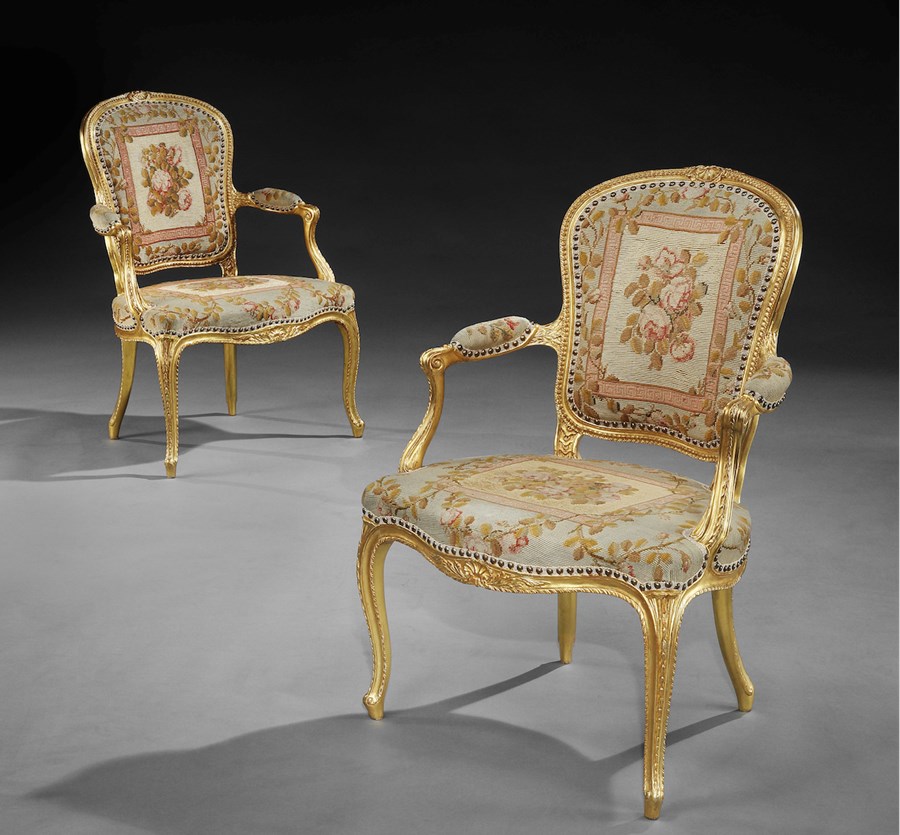
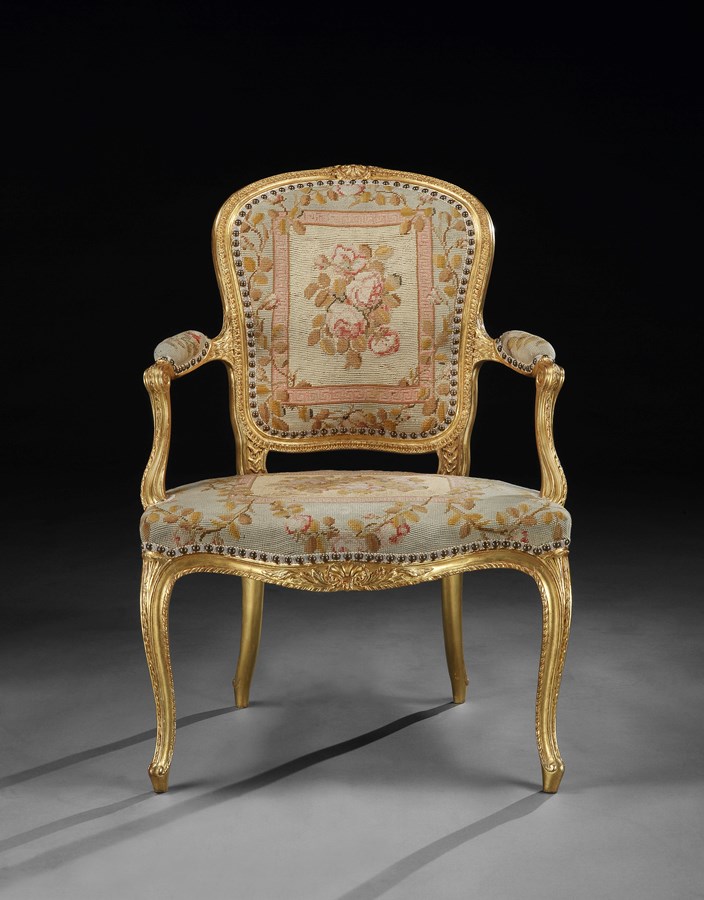
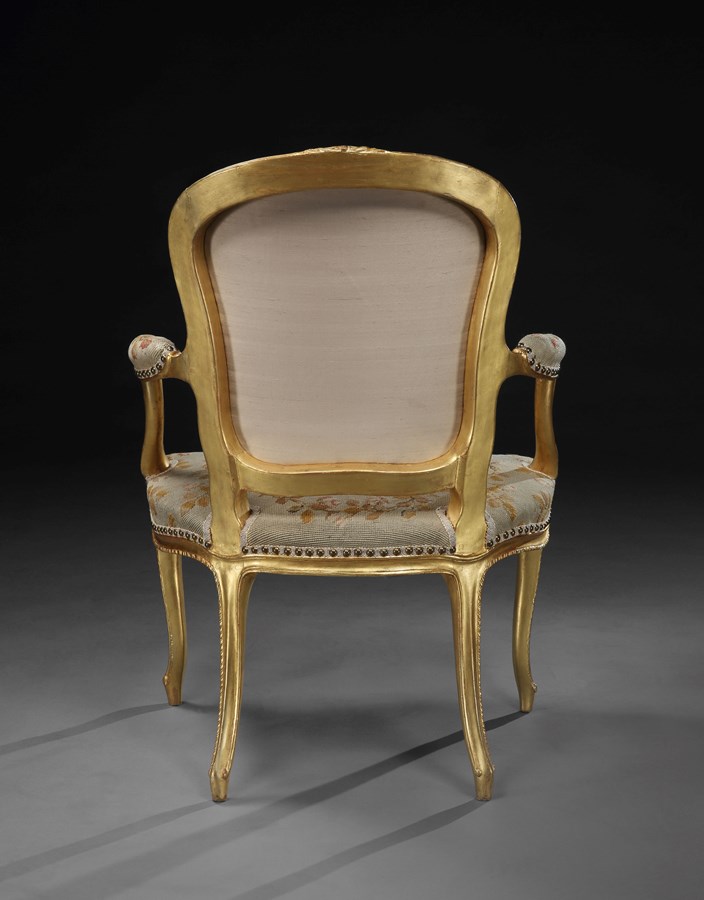
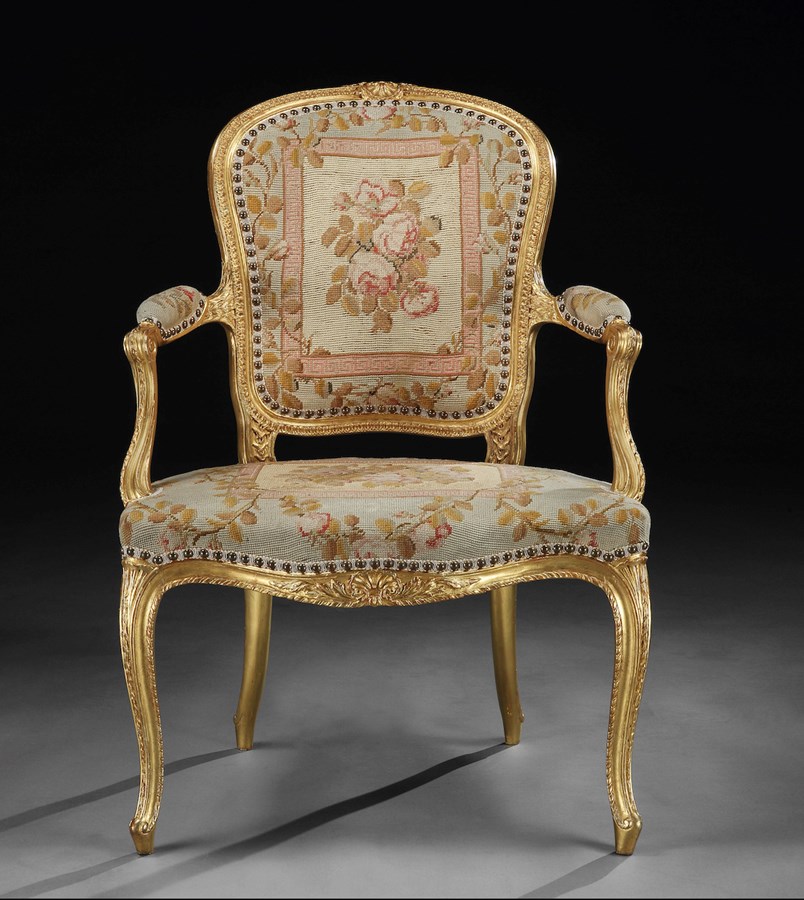


 enquire
enquire
 +44 (0)20 7839 5671
+44 (0)20 7839 5671
 +44 (0)7725 332 665
+44 (0)7725 332 665

